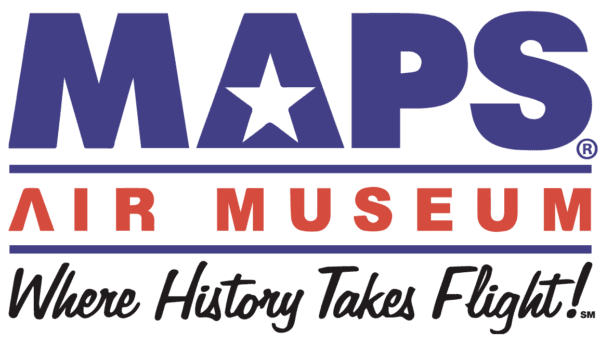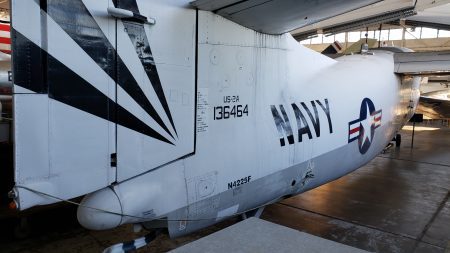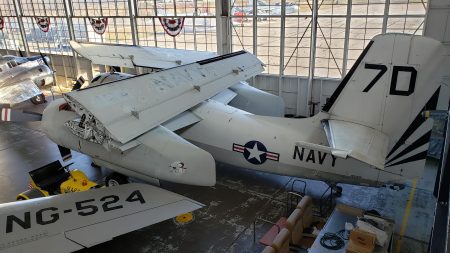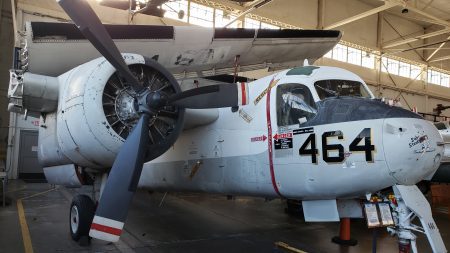Our Aircraft’s History
Grumman S2F-1 Model G-89 “Tracker” (Bureau #136464; MSN 373) ~ Sometimes nicknamed the “Stoof”, our Tracker was manufactured by the Grumman Corporation in Bethpage, New York in March of 1956. She was accepted by the US Navy on March 29, 1956 and given her first assignment at the Sea Control Squadron (VS) 36, Naval Station, Norfolk, Virginia. Hopping around many bases, as seen below:
- July 1959 – Naval Air Station (NAS), Pensacola, Florida; Converted to S2F-1S
- March 1960 – VS-39, NAS, Quonset Point, Rhode Island
- May 1960 – VS-34, NAS Quonset Point, Rhode Island; deployment on the USS Essex (CVS-9)
- October 1960 – VS-20, NAS Quonset Point, Rhode Island
- July 1962 – Naval Air Reserve Training Command (NART), NAS, Grosse Ile, Michigan; redesignated S-2B
- February 1963 – NAS, Pensacola, Florida; Converted to S-2F
- September 1963 – NART, NAS, Grosse Ile, Michigan
- January 1968 – NAS, Pensacola, Florida; converted to US-2A
- October 1969 – NAS, Atsugi, Japan
- July 1970 – Naval Air Support Unit (NASU), Iwakuni, Japan NAS, Atsugi, Japan
- September 1970 – Naval Air Facility (NAF), Atsugi, Japan
- April 1971 – NAS, North Island, California
- July 1971 – Naval Air Reserve Unit (NARU), Memphis, Tennessee
- March 1975 – NARU, North Island, California
- July 1975 – NARU, Whidbey Island, Washington
- June 1978 – NARU, Memphis, Tennessee
- March 1980 – Placed in storage at the Military Aviation Storage & Disposal Center (MASDC) as 1S0750, Davis-Montham Air Force Base, Arizona, March 28, 1980
- May 17, 1989 – Sold to private owner
- March 2000 – Sold to Aviation Business Corporation, St. Louis, Missouri and designated N4225F
Arriving at the MAPS Air Museum on May 2007 on an indefinite loan from a private owner, she is maintained by Crew Chief Kim Kovesci.
Specifications/Performance
- Role: Anti-submarine warfare (ASW)
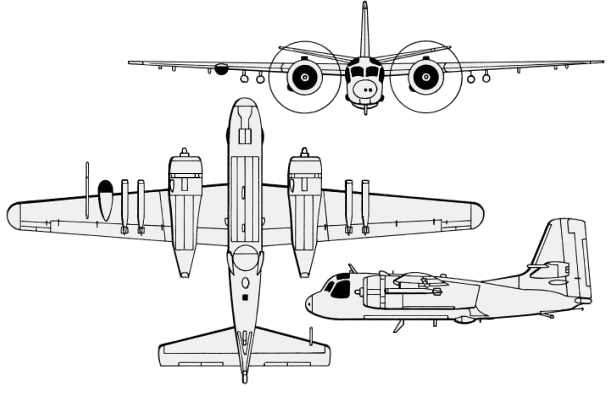
- Manufacturer: Grumman
- First flight: December 4, 1952
- Introduction: February 1954
- Built: 1,284
- Retired: August 19, 1976 (US Navy)
- Crew: 4 (two pilots, two detection systems operators)
- Length 43 ft 6 in
- Wingspan 72 ft 7 in
- Height: 17 ft 6 in
- Empty weight: 18,315 lb
- Max takeoff weight: 26,147 lb
- Engines: 2 x Wright R-1820-82WA radial engines, 1,525 hp each
- Max speed: 280 mph at sea level
- Cruise speed: 150 mph
- Range: 1,350 mi or 9 hours endurance
- Service ceiling: 22,000 ft
Armament, notable
- Torpedoes: Mk. 41, 43, 34, 44 or 46
- Depth charges: Mk 54 or naval mines
- AN/APS-38 radar
- Magnetic Anomaly Detector (MAD) AN/ASQ-8
- JEZEBEL sonobuoys
- AN/AQA-7
Museum display notes: display with the 7D tail code (NAS Dallas, Texas) and with the markings of its US-2A days as a light transport/target tug
Designed to replace: Grumman AF “Guardian”
Replaced by: Lockheed S-3 “Viking”
